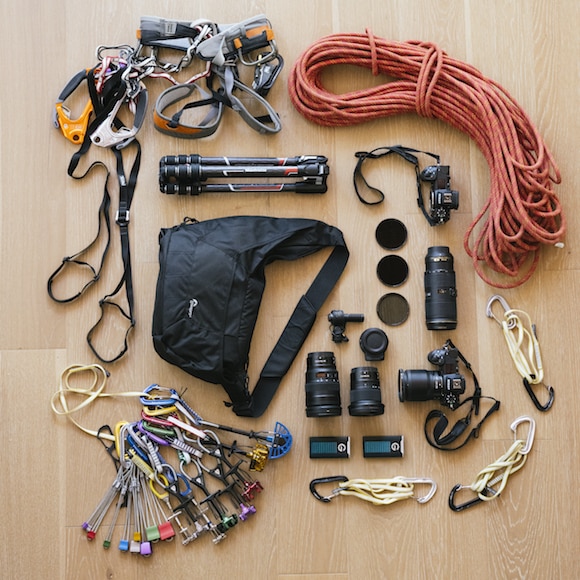One of the most common questions I get is, how do you shoot climbing photos? I thought it’d be fun to provide a few gear tips for anyone interested in getting into climbing photography.
Less is more. This is true in general, but especially in scenarios where you have to ascend ropes or rappel down cliff faces to get into position.
The less equipment you have with you the more you can focus on creativity. It’s a mantra that I think applies not just to photography and filmmaking, but all things in life, even climbing.
Choose what’s best. Because moments are fleeting—especially in climbing where body positions are constantly changing or climbers are even taking unexpected falls—I’m always looking for the best gear. To me, “best” means reliable, durable, light, and fast.
Currently, I’m using either the Nikon Z7 or the Nikon Z6. I will choose the Nikon Z7 when I need higher resolution, but when I want speed or video optimization, which is most of the time these days, I will opt for the Nikon Z6.
For lenses, I carry the Nikon Z 14-30mm f/4, the Nikon Z 24-70mm f/2.8, and the lightweight Nikon AFS 70-200mm f/4 with an FTZ mount adaptor (though I will be replacing this lens with the Nikon Z 70-200 f/2.8 as soon as it arrives).
With this trio of awesome Nikkor glass, I can shoot virtually any scenario or situation in the climbing space. If I have to choose one lens to leave behind, I’ll leave the mid-range Nikon Z 24-70mm f/2.8—or at least swap it for the fast Nikon Z 50mm f/1.8 prime.
Stay organized. I use a Lowepro Passport Sling Bag that I can easily swing around my shoulder to get what I need, or even clip it to the wall with a carabiner to get the weight off my body.
Build solid systems. I have a comfortable harness along with two mechanical ascenders with nylon aiders that allow me to ascend a fixed rope—typically, a 60-meter static rope.
I carry plenty of extra carabiners and slings, which helps get stuff off my body, as well as a small rack of climbing gear to build anchors and pull myself into the wall to stabilize myself in precarious positions.
Sometimes, I will clip my camera strap to my ascender such that it helps me create stability, especially when shooting handheld video.
Think about video. With most of today’s cameras boasting both still and video-recording capabilities, it’s a no brainer to shoot still and motion in tandem.
I make sure to always have a super light Manfrotto tripod in the car in case I want to shoot long exposures or lock off a video shot, but the tripod never goes up on the wall with me.
I’ll also carry the Nikon ME1 microphone for recording impressively high-quality audio for on-the-fly interviews or on-the-wall action shots.
Don’t forget the small stuff. Always bring extra memory cards, extra camera batteries (keep them in your pocket if it’s cold!), cleaning equipment for lenses, and maybe a windbreaker and gloves for your comforts protection because if you get cold you will not be able to focus on making pictures.
And I’ll never head out without a few terabytes of G-technology G-Drive Mobile SSDs to backup my work redundantly. As I said, moments are fleeting and can’t be re-created, so you never want to lose your whole shoot.
